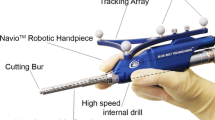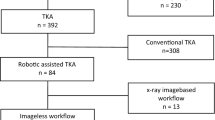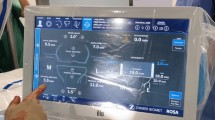Abstract
In recent years, robotic technology is becoming more pervasive in joint arthroplasty. The role of robotics in joint replacement surgery is to bring precision and accuracy in bone preparation, implant positioning and soft tissue balancing. However, there is yet to be a study conducted to determine the accuracy of bone preparation done by a new robotic system. The purpose of this study is to evaluate and report on the accuracy of bone cuts using imageless semiautonomous freehand robotic sculpting system, Navio (Smith & Nephew) based on the data provided by the robotic system. Between August 2018 and May 2019, a total of 62 patients were prospectively enrolled in this study. All surgeries were done by the senior author using a medial para-patellar approach and using a posterior stabilised implant (Anthem, Smith & Nephew Inc.). The study included 37 female patients and 25 male patients. The parameters assessed in this study were: (1) mechanical axis, (2) femoral coronal alignment, (3) femoral rotation, (4) femoral sagittal alignment, (5) tibial slope and (6) tibial coronal alignment using paired t test and root mean squared error (RMSE). The robotic system was accurate in achieving the bone cuts as planned in mechanical axis alignment (p = 0.89, RMSE = 0.56), femoral coronal alignment (p = 0.36, RMSE = 0.36), femoral sagittal alignment (p = 0.10, RMSE = 0.44), femoral rotation (p = 0.91, RMSE = 0.11), tibial coronal alignment (p = 0.81, RMSE = 0.24) and tibial slope (p = 0.30, RMSE = 0.37) with the maximum RMSE being 0.56. This study demonstrated that semi-autonomous hand-held robotic system, Navio (Smith & Nephew) for total knee arthroplasty produced accurate component positioning as per plan in all planes. The maximum RMSE was 0.56°.






Similar content being viewed by others
References
Choi Y-J, Ra HJ (2016) Patient satisfaction after total knee arthroplasty. Knee Surg Relat Res 28(1):1–15
Babazadeh S, Stoney JD, Lim K, Choong PFM. The relevance of ligament balancing in total knee arthroplasty: how important is it? A systematic review of the literature. Orthop Rev [Internet]. 2009 Oct 10 [cited 2021 Mar 1];1(2). https://www.ncbi.nlm.nih.gov/pmc/articles/PMC3143981/
Lonner JH, Fillingham YA (2018) Pros and cons: a balanced view of robotics in knee arthroplasty. J Arthroplasty 33(7):2007–2013
Bonner TJ, Eardley WGP, Patterson P, Gregg PJ (2011) The effect of post-operative mechanical axis alignment on the survival of primary total knee replacements after a follow-up of 15 years. J Bone Jt Surg Br 93-B(9):1217–1222
Berend ME, Ritter MA, Meding JB, Faris PM, Keating EM, Redelman R et al (2004) The Chetranjan Ranawat Award: tibial component failure mechanisms in total knee arthroplasty. Clin Orthop 428:26–34
Werner SD, Stonestreet M, Jacofsky DJ (2014) Makoplasty and the accuracy and efficacy of robotic-assisted arthroplasty. Surg Technol Int 24:302–306
Ethgen O, Bruyère O, Richy F, Dardennes C, Reginster J-Y (2004) Health-related quality of life in total hip and total knee arthroplasty. A qualitative and systematic review of the literature. J Bone Jt Surg Am 86(5):963–974
Gunaratne R, Pratt DN, Banda J, Fick DP, Khan RJK, Robertson BW (2017) Patient dissatisfaction following total knee arthroplasty: a systematic review of the literature. J Arthroplasty 32(12):3854–3860
Casper M, Mitra R, Khare R, Jaramaz B, Hamlin B, McGinley B et al (2018) Accuracy assessment of a novel image-free handheld robot for total knee arthroplasty in a cadaveric study. Comput Assist Surg 23(1):14–20
Bollars P, Boeckxstaens A, Mievis J, Kalaai S, Schotanus MGM, Janssen D (2020) Preliminary experience with an image-free handheld robot for total knee arthroplasty: 77 cases compared with a matched control group. Eur J Orthop Surg Traumatol Orthop Traumatol 30(4):723–729
Mullaji A, Kanna R, Marawar S, Kohli A, Sharma A (2007) Comparison of limb and component alignment using computer-assisted navigation versus image intensifier-guided conventional total knee arthroplasty. J Arthroplasty 22(7):953–959
Chin PL, Yang KY, Yeo SJ, Lo NN (2005) Randomized control trial comparing radiographic total knee arthroplasty implant placement using computer navigation versus conventional technique. J Arthroplasty 20(5):618–626
Hernández-Vaquero D, Suarez-Vazquez A, Sandoval-Garcia MA, Noriega-Fernandez A (2010) Computer assistance increases precision of component placement in total knee arthroplasty with articular deformity. Clin Orthop 468(5):1237–1241
Cheng T, Zhao S, Peng X, Zhang X (2012) Does computer-assisted surgery improve postoperative leg alignment and implant positioning following total knee arthroplasty? A meta-analysis of randomized controlled trials? Knee Surg Sports Traumatol Arthrosc 20(7):1307–1322
Liow MHL, Xia Z, Wong MK, Tay KJ, Yeo SJ, Chin PL (2014) Robot-assisted total knee arthroplasty accurately restores the joint line and mechanical axis. A prospective randomised study. J Arthroplasty 29(12):2373–2377
Liow MHL, Goh GS-H, Wong MK, Chin PL, Tay DK-J, Yeo S-J (2017) Robotic-assisted total knee arthroplasty may lead to improvement in quality-of-life measures: a 2-year follow-up of a prospective randomized trial. Knee Surg Sports Traumatol Arthrosc 25(9):2942–2951
Bellemans J, Colyn W, Vandenneucker H, Victor J (2012) The Chitranjan Ranawat Award: is neutral mechanical alignment normal for all patients?: the concept of constitutional varus. Clin Orthop 470(1):45–53
Howell SM, Howell SJ, Kuznik KT, Cohen J, Hull ML (2013) Does a kinematically aligned total knee arthroplasty restore function without failure regardless of alignment category? Clin Orthop 471(3):1000–1007
Ren Y, Cao S, Wu J, Weng X, Feng B (2019) Efficacy and reliability of active robotic-assisted total knee arthroplasty compared with conventional total knee arthroplasty: a systematic review and meta-analysis. Postgrad Med J 95(1121):125–133
Clark TC, Schmidt FH (2013) Robot-assisted navigation versus computer-assisted navigation in primary total knee arthroplasty: efficiency and accuracy. ISRN Orthop 2013:1–6
Brin YS, Nikolaou VS, Joseph L, Zukor DJ, Antoniou J (2011) Imageless computer assisted versus conventional total knee replacement. A Bayesian meta-analysis of 23 comparative studies. Int Orthop 35(3):331–339
Mason JB, Fehring TK, Estok R, Banel D, Fahrbach K (2007) Meta-analysis of alignment outcomes in computer-assisted total knee arthroplasty surgery. J Arthroplasty 22(8):1097–1106
Song E-K, Seon J-K, Park S-J, Jung WB, Park H-W, Lee GW (2011) Simultaneous bilateral total knee arthroplasty with robotic and conventional techniques: a prospective, randomized study. Knee Surg Sports Traumatol Arthrosc 19(7):1069–1076
Lonner JH, Smith JR, Picard F, Hamlin B, Rowe PJ, Riches PE (2015) High degree of accuracy of a novel image-free handheld robot for unicondylar knee arthroplasty in a cadaveric study. Clin Orthop 473(1):206–212
Moon Y-W, Ha C, Do K-H, Kim C-Y, Han J-H, Na S-E et al (2012) Comparison of robot-assisted and conventional total knee arthroplasty: a controlled cadaver study using multiparameter quantitative three-dimensional CT assessment of alignment. Comput Aided Surg 17(2):86–95
Vaidya NV, Deshpande AN, Panjwani T, Patil R, Jaysingani T, Patil P. Robotic-assisted TKA leads to a better prosthesis alignment and a better joint line restoration as compared to conventional TKA: a prospective randomized controlled trial. Knee Surg Sports Traumatol Arthrosc. Epub ahead of print. PMID: 33165631 https://doi.org/10.1007/s00167-020-06353-2
Sikorski JM (2008) Alignment in total knee replacement. J Bone Jt Surg Br 90(9):1121–1127
Acknowledgements
The authors acknowledge the contributions of Dr. Mukund Dhaniwala, Dr. Dhruva Chikara, Dr. Vikas Sonule, Dr. Nilesh Kulkarni for collecting the required data for the study.
Funding
No external funding was provided for this study.
Author information
Authors and Affiliations
Corresponding author
Ethics declarations
Conflict of interest
All the authors namely Dr. Narendra Vaidya, Dr. Tanmay N. Jaysingani, Dr. Taufiq Panjwani, Dr. Rakesh Patil, Dr. Ajinkya Deshpande and Dr. Abhinav Kesarkar declare that they have no conflict of interest.
Ethical approval
All procedures performed in this study including human participants were in accordance with the ethical standards of the institutional and/or national research committee and with the 1964 Helsinki Declaration and its later amendments or comparable ethical standards. The study was approved by the Ethical Committee and the Institutional Review Board.
Informed consent
All procedures followed were in accordance with the ethical standards of the responsible committee on human experimentation (institutional and national) and with the Helsinki Declaration of 1975, as revised in 2000. Informed consent was obtained from all patients for being included in the study.
Additional information
Publisher's Note
Springer Nature remains neutral with regard to jurisdictional claims in published maps and institutional affiliations.
Rights and permissions
About this article
Cite this article
Vaidya, N., Jaysingani, T.N., Panjwani, T. et al. Assessment of accuracy of an imageless hand-held robotic-assisted system in component positioning in total knee replacement: a prospective study. J Robotic Surg 16, 361–367 (2022). https://doi.org/10.1007/s11701-021-01249-w
Received:
Accepted:
Published:
Issue Date:
DOI: https://doi.org/10.1007/s11701-021-01249-w




